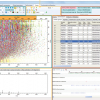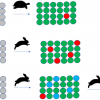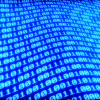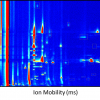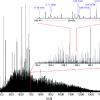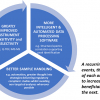Antony N. Davies,a,b Robert Hansonc and Robert Lancashired
aSERC, Sustainable Environment Research Centre, Faculty of Health, Sport and Science, University of Glamorgan, UK
bDirector, Analytical Laboratory Informatics Solutions
c St Olaf College, Northfield, MN 55057, USA
dUniversity of the West Indies, Mona Campus, Kingston, Kgn 7, Jamaica
Introduction
Do you have a problem? Is there an area of your work where you find it difficult to move your data between your analytical instruments and your data analysis and reporting packages? If so we need to hear from you now! This month’s column will look at some of the on-going development work in the standards arena and is also a direct appeal for you—as you read this—to spend two minutes thinking of areas where we could make your work easier.
IUPAC Subcommittee on Electronic Data Standards
Robert Lancashire has been his usual active self in recent months. He has been looking at different aspects of the application of the IUPAC JCAMP-DX range of standards and has posed the question around the areas that the IUPAC Subcommittee on Electronic Data Standards (SEDS) has formal oversight. To date there are standards documented in the spectroscopic fields of infrared and nuclear magnetic resonance (NMR) spectroscopy, mass and ion mobility spectrometry, as well as electron magnetic resonance spectroscopy. The subcommittee also took on the difficult task of standardising the reporting of the more common NMR pulse sequences. It is also possible to find vendors who have taken the step of deploying a version “adopted” from the original Infrared Standard for their own particular instrumentation types.1,2,3,4,5,6,7
Looking at my archives it is clear that the diversion of effort into supporting the activities of the ASTM AnIML committee has left an area without fundamental developmental support for new standards. In order to avoid duplication of effort in developing the extensible mark-up language (XML) versions of the various analytical data standards the decision made by SEDS to combine their work on XML in Chemistry with the AnIML committee was correct. The timescales this committee works to has meant that it has left a gap where the active support of new communities has been concerned and the development of new data dictionaries, the key to any standardisation effort for scientific data, has effectively ground to a halt. Indeed the IUPAC project to look at better standardising near infrared spectroscopy data and chemometric data was terminated to await the completion of the AnIML work.
Circular dichroism (CD)
One notable exception has been the recent work being led by Professor Bonnie Wallace of the Department of Crystallography at the Institute of Structural and Molecular Biology, Birkbeck College, University of London and her team who have been working on a new JCAMP-DX standard for CD data.
This work has been specifically targeted at producing a CD and Synchrotron Radiation Circular Dichroism (SRCD) Spectroscopic data standard to work with the Protein Circular Dichroism Data Bank, an online facility for data deposition and retrieval for CD and SRCD spectra and associated standardised metadata. The protocol for this new standard has been submitted to Pure and Applied Chemistry and will be available shortly for perusal.8,9
Integration of JMOL with JspecView
Robert Lancashire has been singing the praises of Bob Hanson (Jmol developer) who has been applying apparently unlimited energy into programming code to integrate Robert’s JSpecView functionality.
The Jmol/JSpecView merger has been going ahead very quickly and many changes are still going on. The latest Jmol has JSpecView embedded so if you open the Jmol application and read a JDX file with a molfile inside it will launch JSpecView when you click on the menu.
If you would be interested in taking a peek—or even helping test this alpha version to aid the developers—there are demonstrations running on Robert Lancashire’s website at http://wwwchem.uwimona.edu.jm/spectra/JSpecView2/sample; click on the HTML files there to run the demos and please don’t forget to comment. For those of you not online at the moment the following figures give you some idea of the integrated capability.
Figure 1 shows Robert’s, by now legendary, acetophenone integration. Here it is possible to show the molecular vibrations by clicking on the labelled peaks within the infrared spectrum.

Figures 2 and 3 show the integration testing for the same compound but this time highlighting the individual nuclei that give rise to the signals in the HNMR and CNMR spectra, respectively. You should try clicking on both the spectra to activate the highlights in the molecule and vice versa.


In Figure 4 you will see the molecule change as now the respective molecular fragment is shown if you click on the mass spectrum peaks.

Now remember this is the alpha version so switching between display modes is currently not as smooth as it will be with the first release version, but please provide feedback on anything you particularly like or dislike or where you see a need not being met. A future development plan is to enable JSpecView to handle the draft JCAMP-DX 6.0 NMR data formats.
If you wish to talk directly to the developers they will be appearing at the American Chemical Society’s Division of Chemical Education sponsored Biennial Conference on Chemical Education (BCCE) at Pennsylvania State University between 27 July and 2 August and I am working on getting Robert Lancashire over to Europe in the near future.12
References
- R.S. McDonald and P.A. Wilks Jr, “JCAMP-DX: A standard form for exchange of infrared spectra in computer readable form”, Appl. Spectrosc. 42, 151–162 (1988). doi: 10.1366/0003702884428734
- J. Gasteiger, B.M.P. Hendriks, P. Hoever, C. Jochum and H. Somberg, “JCAMP-CS: A standard exchange format for chemical structure information in computer-readable form”, Appl. Spectrosc. 45, 4–11 (1991). doi: 10.1366/0003702914337894
- A.N. Davies and P. Lampen, “JCAMP-DX for NMR”, Appl. Spectrosc. 47, 1093–1099 (1993). doi: 10.1366/0003702934067874
- A.N. Davies, J. Lambert, R.J. Lancashire, P. Lampen, W. Conover, M. Frey, M. Grzonka, E. Williams and D. Meinhart, “Guidelines for the representation of pulse sequences for solution-state nuclear magnetic resonance spectrometry (IUPAC Recommendations 2001)”, Pure Appl. Chem. 73, 1749–1764 (2001). doi: 10.1351/pac200173111749
- P. Lampen, H. Hillig, A.N. Davies and M. Linscheid, “JCAMP-DX for mass spectrometry”, Appl. Spectrosc. 48, 1545–1552 (1994). doi: 10.1366/0003702944027840
- J.I. Baumbach, P. Lampen and A.N. Davies, “JCAMP-DX. A standard format for the exchange of ion mobility spectrometry data (IUPAC Recommendations 2001)”, Pure Appl. Chem. 73, 1765–1782 (2001). doi: 10.1351/pac200173111765
- P. Lampen, J. Lambert, R.J. Lancashire, R.S. McDonald, P.S. McIntyre, D.N. Rutledge, T. Fröhlich and A.N. Davies, “An extension to the JCAMP-DX standard file format, JCAMP-DX V.5.01”, Pure Appl. Chem. 71, 1549–1556 (1999). doi: 10.1351/pac199971081549
- http://pcddb.cryst.bbk.ac.uk/home.php
- L. Whitmore, B. Woollett, A.J. Miles, D.P. Klose, R.W. Janes and B.A. Wallace, “PCDDB: the protein circular dichroism data bank, a repository for circular dichroism spectral and metadata”, Nucleic Acids Res. 39, D480–D486 (2011). doi: 10.1093/nar/gkq1026
- http://wwwchem.uwimona.edu.jm/spectra/JSpecView2/sample
- http://wiki.jmol.org/index.php/Main_Page
- http://www.2012bcce.com/




